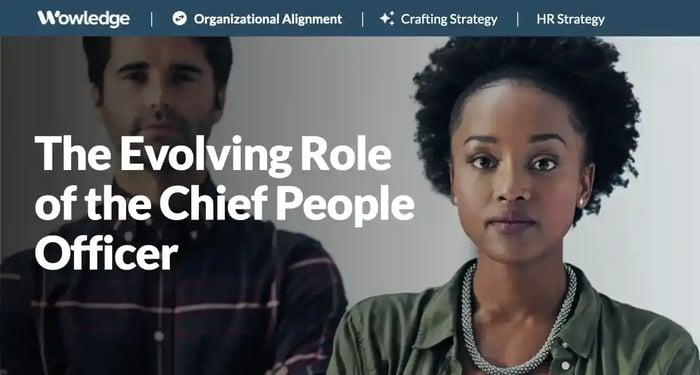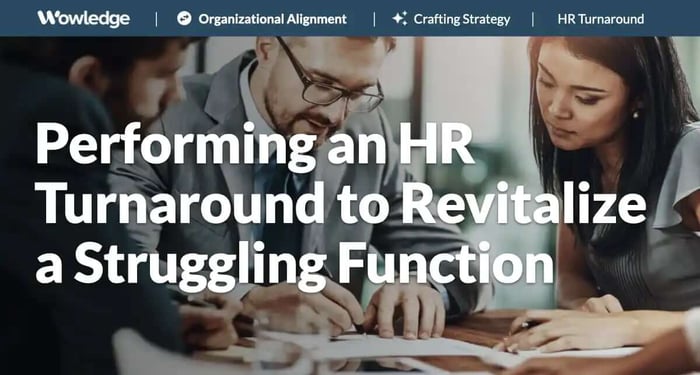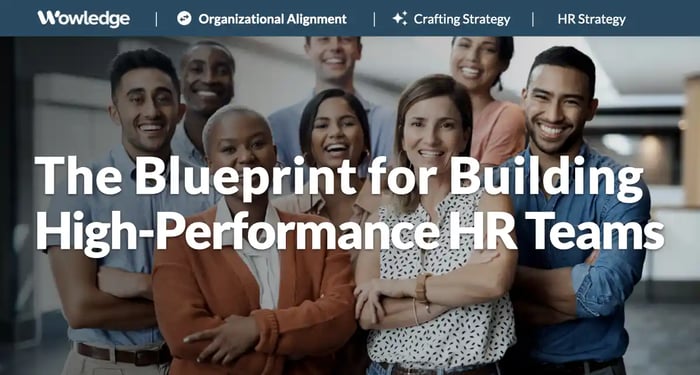Table of Contents
- Key responsibilities of the modern CPO or CHRO
- Key differentiating areas of expertise of a leading CPO
- The priorities of a modern CPO
- 1. Building strategic alignment
- 2. Focusing on culture and employee experience (EX)
- 3. Encouraging innovation and adaptation
- 4. Promoting data-driven decision support
- 5. Facilitating C-Suite collaboration
- 6. Driving transformation and change management
- 7. Developing leaders and planning for their succession
- 8. Championing diversity, equity, inclusion (DEI) and well-being
- Critical skills for effectively managing C-Suite relationships
- What HR roles are most critical to the success of a CPO?
- Relevant Practices & Tools
- FAQs
The Chief People Officer (CPO) is a well-established role that has evolved substantially over the past century. Grounded in the “personnel” or “industrial relations” manager role created in the early 20th century, it has gone from a largely administrative role to one of the champion who is focused on culture, talent management, productivity, and workforce optimization. The role is alternatively referred to as a Chief Human Resource Officer (CHRO), or Vice President of Human Resources (VPHR). Similarities exist with the role of the HR Business Partner (HRBP), inasmuch as the CPO is a broad-based and skilled leader whose focus is on impacting the business through people strategies, but the role is significantly more demanding in its potential for reach and impact, with direct oversight responsibility for all HR capabilities.
The role continues to evolve as external forces create pressure on organizations to maintain a sufficiently sized workforce with the right combination of skills that support their mission. In particular, key trends include the rapid adoption and impact of artificial intelligence (AI) and robotics, hybrid work locations, and the preponderance of negative trends around talent shortages, increased turnover and mobility, and creeping (but rapid) skills obsolescence. The demands are only increasing with the now-dominant Millennials and their newer Gen Z counterparts bringing a desire for greater environmental social and community awareness, more meaningfulness in their work, and greater linkages between their closely held values and those of the company. The modern Chief People Officer must be able to simultaneously look outward to foresee employment and market trends while looking inward for workforce and workplace issues that impede the meeting of corporate objectives.
Key responsibilities of the modern CPO or CHRO
The primary purpose of the CPO or CHRO role is to define and plan HR strategies and initiatives aligned with organizational business direction and lead the HR team in the creation of programs to achieve those. As a member of the top leadership team, the ability to envision and create action on longer-term strategies is elemental and needs to be balanced with oversight of operational excellence of the HR administrative and functional processes. Primary responsibilities include:
- Developing and implementing HR strategies and plans designed to drive the achievement of company goals and objectives.
- Acting as a strategic advisor to leadership to develop and maintain management tactics to attract, hire, motivate, engage, and retain high-quality talent.
- Clarifying and driving the organization's culture and values that are linked to the mission, and are constructive, supportive, and inclusive.
- Driving an effective and continuously improving HR infrastructure that creates a positive and efficient employee experience, meets regulatory requirements, and provides insights and trends that support employee productivity and performance.
- Providing leadership and direction to the HR team in the design, development, implementation, and adoption of impactful people policies, processes, programs, and practices.
Overall, the CPO's role is integral to creating a productive, engaged, and thriving workforce that contributes to the organization's success. The specific focus and emphasis on these elements can vary depending on the organization's size, industry, and strategic priorities.
Key differentiating areas of expertise of a leading CPO
Given the range of activities that the Chief People Officer has to lead, monitor, and oversee, it is no surprise that many find the work rewarding but at times overwhelming. While the ability to prioritize is as important to the CPO as any other role in the C-Suite, addressing the complexities of HR needs across every function, business unit, department, employee segment, and location makes the decision process enormously difficult.
In an HR Executive article, a panel of CHROs and academic experts identified the top five areas of expertise that separate high-performing CPOs from all the others. Those include:
- AI/Analytics – leveraging advanced tools to generate insights into organizational assets, limitations, skill and capability gaps, risks, and potential solutions.
- Work and Organization Models – understanding options to structure the workplace, processes, and policies to align with employee needs and preferences that can maximize the productivity and development needs of the organization.
- Governance – working with external stakeholders, including the board of directors, investors, governmental bodies, suppliers, and customers.
- Transformation – being a change champion and proponent of using robust methodologies to understand when a need exists, what it entails, and how to engage the organization in activating it.
- Business Acumen – having breadth and depth in the drivers, influencers, and barriers to business and operational success across all functions of the organization. This includes having knowledge of broad business topics that are internal (finance, operations, sales), industry (customer, competitor, supplier), and external (public policy, economic, global).
A report by Accenture suggests that to drive impact, the CHRO must evolve to focus on connecting data, technology, and people together with cultivating collaboration. It found that what differentiates “High Resolution” CHROs are six unique capabilities, (in descending order of impact), half of which are more typically aligned with broader (than HR) leadership competencies:
- Systems thinking - synthesizes internal and external complexities, spots connections, and applies those insights to accelerate change.
- Financial acumen – applies deep expertise on financial topics when making decisions and taking action.
- Leadership skills - drives strategic outcomes through aligning, inspiring, and motivating others to work toward a common goal.
- Technology and data skills – understands how to use technology and data to identify improvements for the business, people, and communities.
- Strategic talent development - combines knowledge of how people learn and grow with an awareness of the skills and capabilities the organization needs to create career opportunities to stay competitive.
- Business acumen - recognizes how the business/industry functions and what drives success, while translating that into actions that impact the bottom line and create value for all stakeholders.

The priorities of a modern CPO
The most important ways that a Chief People Officer adds value as a member of the top leadership team are as a partner, coach, and guide on everything that creates the employee ecosystem. From providing useful insights and coaching for C-Suite peers and their potential successors, to how employees are assessed, hired, managed, developed, rewarded, and offboarded, the CPO is focused on optimizing the workforce. A Chief People Officer adds significance by creating a focus on the organization's most valuable assets - its people. Some of the most important ways a CPO contributes to the executive team and the organization as a whole include:
1. Building strategic alignment
Ensuring that people-related strategies and plans align with the overall business goals and objectives. By understanding the company's (and its functions and business units) mission and strategic direction, the CPO can develop and implement human resources strategies that directly support the organization's growth and success. Workforce planning and succession planning are core elements included in this element.
2. Focusing on culture and employee experience (EX)
Playing a critical role in shaping the organization's culture and ensuring a positive employee experience. As a strong and positive culture contributes to increased employee engagement, satisfaction, and productivity, driving the consistent adoption and application of corporate values and standards builds greater workforce alignment with its mission. Establishing processes that regularly bring the employee voice into the design of processes, practices, and programs drives a culture that yields greater engagement and productivity.
3. Encouraging innovation and adaptation
Fostering an environment that encourages innovation, creativity, and adaptability. This includes creating development opportunities that empower employees to learn new skills and adapt to changing market conditions. Agility is a key concept that CPOs should embrace by adopting and promoting continuous improvement and innovation strategies. Promoting such capabilities brings a more flexible and market-driven focus to both the management and staff levels and drives greater returns on product and service development activities.
4. Promoting data-driven decision support
Providing guidance, direction, and recommendations backed up by data, research, and empirical studies. Expand the notion of an enterprise data-driven culture by regularly leveraging employee listening, integrated HR and business metrics, and predictive analytics for the evaluation of business and people issues, strategies, and potential solutions. Create the expectation that business cases will be included in any proposals for new or improved programs, processes, or initiatives.
5. Facilitating C-Suite collaboration
Collaborating with other executives to ensure that people-related considerations are integrated into overall business decisions. By actively engaging and partnering with peers on joint design and development activities that push the organization towards greater goal achievement, the CPO effectively role-models this idealized behavior. Identify opportunities for functional leaders and their organizations to work together to develop jointly beneficial programs and practices (e.g., to better recruit STEM candidates for both engineering and IT). This includes engaging partner organizations in the development of improved HR capabilities, such as advanced analytics, emerging technologies, external partnerships (e.g., outsourcing), and governmental/community relations. Such a holistic approach grounded in a collaborative culture strengthens the organization's ability to achieve its goals.
6. Driving transformation and change management
During periods of organizational change, such as mergers, acquisitions, or restructuring, the CPO helps manage the transition by ensuring open communication, providing support to affected employees, and addressing concerns. Similarly, other transformations might include the introduction of new products and services, technologies, partnerships, or work processes. The Chief People Officer should recognize the potential impact on targeted groups and create a team capable of managing the smooth transition and adoption of change.
7. Developing leaders and planning for their succession
Coaching top leaders on their people and collaboration strategies and actions, identifying and cultivating future leaders, and providing development aligned with future business needs. The CPO is in the unique position to provide objectively based definitions and assessments of leadership quality and potential. As such, recognizing the strengths and development needs of current and future managers and leaders are essential elements of building a sustainable pool of well-qualified, prepared, and future-ready leaders of the business.
8. Championing diversity, equity, inclusion (DEI) and well-being
Leading efforts to create a workplace that is accepting of an increasingly diverse workforce and comfortable for people in both physical and psychological senses. This not only aligns with societal values but also enhances the organization's ability to tap into a wide range of perspectives, which can drive innovation and better decision-making. Prioritizing employee well-being through wellness programs, flexible work arrangements and mental health initiatives can improve morale, reduce burnout, and increase overall employee satisfaction.
A skilled Chief People Officer contributes to the organization's growth, resilience, and long-term success by nurturing a thriving workforce, aligning human resources strategies with business goals, and creating a workplace that values and supports its employees. While the list is long, it is reflective of the range of issues and challenges that a modern CPO or CHRO must delve into.

Critical skills for effectively managing C-Suite relationships
Building and maintaining strong relationships with peer executives is as important as ever. It is especially crucial for CPOs and CHROs in a time when their average tenure is reported by Korn Ferry as only 3.7 years, calling out the need to build and maintain a reputation for providing high-value partnerships and support with C-Suite team members as essential. The key is to ensure that people-related strategies are aligned with overall business goals, that the value offered to (them and) the organization is clear, and that the organization's workforce is primed for success. Here are steps that a Chief People Officer can take to foster positive relationships with other C-Suite executives:
- Understand business priorities. Gain a deep understanding of the organization's overall strategic objectives, financial goals, and key challenges. Demonstrate that understanding by using it to articulate inputs to business strategies and issues. Align people-related initiatives and strategies with these business priorities to demonstrate the CPO's contribution to the organization's success.
- Communicate value. Clearly articulate how people-related initiatives contribute to the achievement of business objectives. Show how investing in talent, culture, and employee well-being directly impacts the bottom line. Use blended business, financial, and HR data and analytics to present evidence of the impact of HR initiatives on organizational performance. Show how people-related efforts contribute to cost savings, revenue growth, and improved productivity.
- Build trust and credibility. Establish credibility by demonstrating expertise in human resources, industry trends, and organizational dynamics. Be transparent, honest, and reliable in interactions with other C-Suite members. Build trust through consistent and open communication. Practice good listening, feedback, and coaching skills to develop a reputation as a trusted sounding board and advisor.
- Collaborate actively. Seek opportunities to collaborate with other C-Suite members on cross-functional projects and initiatives. Actively participate in strategic discussions that involve people-related considerations, such as mergers, acquisitions, or organizational restructuring. Actively seek input from other C-Suite members regarding their perspectives on HR matters. Incorporate those insights into HR strategies. Encourage feedback on HR initiatives to ensure alignment with broader business goals.
- Speak the language of business. Communicate Human Resources or People concepts in a way that resonates with other C-Suite executives. Frame discussions in terms of financial impact, risk management, and strategic value. Highlight how HR initiatives align (e.g., statistically) with key performance indicators (KPIs) that matter to the organization. Keep informed about industry trends, regulatory changes, and best practices in human resources. Use this knowledge to guide discussions and decisions. Become a continuous learner on subjects related to the core business – software development, structural engineering, oil exploration, medical procedures and advances, etc.
- Lead by example. Embody the values and behaviors being promoted in the organization. Display strong leadership skills, emotional intelligence, and a commitment to collaboration. Act in accordance with the standards set forth in HR policies, practices, and programs, such as those in leadership and management development programs, competency models, corporate values, and so on.
When taking these steps, a Chief People Officer can establish themselves as a valued and respected member of the C-Suite, contributing to the organization's success through effective people management strategies and collaboration with other executives.

What HR roles are most critical to the success of a CPO?
As the leader of the HR organization, the success of a Chief People Officer (CPO) relies on a well-rounded team that can effectively support and execute the various responsibilities and initiatives within the function. While the range of HR functions has not changed appreciably, the areas of primary focus have. In addition to the traditional roles related to recruiting, compensation and benefits, employee relations, training, HR administration, and HRIS, some critical team roles have risen to the top from a strategic impact perspective. These can be staffed either as stand-alone roles or as skill sets held by individuals with other combined responsibilities.
1. HR Business Partners (HRBPs)
HRBPs act as liaisons between the HR department and business units. They understand the specific needs of different departments and align HR strategies with overall business objectives. Their role involves strategic planning, talent management, and employee relations. These roles, even if held by only a few, are the integrators of much that HR offers to the organization, and a direct extension of the CPO or CHRO.
2. Employee Experience Managers
These managers are dedicated to enhancing the overall employee experience by implementing initiatives related to employee engagement, well-being, and work-life balance. They are solution generators who leverage employee listening methods to develop and improve processes that employees prioritize as either major pain points or joy-inducers.
3. HR Analytics and Data Specialists
With the increasing importance of data-driven decision-making, these specialists analyze HR metrics to provide insights into workforce trends, helping the organization make informed decisions. Moving beyond the HRIS reporting role, these individuals have skills in leveraging advanced statistical methods, data storage, processing technologies, presentation, and insight generation support.
4. Organizational Development Specialists
These specialists focus on assessing and improving organizational effectiveness, including areas like change management, team dynamics, and cultural transformation. The role (even if paired with traditional learning and development responsibilities) is essential to the consultative HR capabilities that help drive demonstrable business value by the HR team. They design tailored solutions to the most challenging workforce issues around the intersection of individuals, teams, workflows, technologies, and organization structure.
5. Change Management Specialists
As organizations undergo transformations, these specialists help manage the people-related aspects of change, ensuring smooth transitions and the adoption of new processes. Their skills in designing communications, identifying training requirements and programs, engaging leaders and influencers, and driving adoption strategies are highly valued in times when a wide variety of changes and challenges are being faced by organizations.
6. Wellness and Health Promotion Coordinators
With the focus on (and employee calls for) monitoring and improving employee well-being, these individuals are responsible for designing wellness programs, health initiatives, and mental health support. The skills may come from the benefits or totals rewards teams, but the capability requires skills in monitoring the organization for signs of stress in benefits, OSHA, or payroll data (e.g., mental health claims, illness or injury-related claims, absentee rates), employee surveys (e.g., engagement, pulse), and HR transaction activity data (e.g., turnover, transfers).
The composition of the team may vary based on the organization's size, industry, and specific priorities. A diverse and skilled HR team can provide the necessary expertise and support to help the Chief People Officer successfully execute the organization's people-focused strategies and keep up with the evolving demands of the role. In the end however, it is the successful coordination and choreographing of the team's capabilities and efforts that make an indelible impact on the company’s culture, experience, brand, productivity, and effectiveness.
Relevant Practices & Tools
Emerging Change Management Practices to Grow the Company’s Change Capacity. >
The pace of change has grown exponentially. As technology advances, information is now readily available, and the lines between work life and personal life blur. In response... more »
Understanding Business Strategies to Align the HR Direction. >
Core to the development of an HR strategy is building an understanding of the key business strategies and initiatives that must be accomplished during the term of the plan... more »
Creating an Employee Experience that Bonds High Performers to the Organization. >
Employee experience constitutes the entire journey an employee takes with the organization. This includes everything from pre-hire to post-exit interactions and everything in between... more »
Analyzing Leadership Development Skill and Capability Gaps. >
Once competencies are defined and participants are identified, it is possible to conduct a more detailed needs analysis. This involves collecting data on each potential program participant... more »
The Leadership Strategy Template: Define an Idealized Vision of the Attributes and Capabilities of Leaders in an Organization. >
A starting point for creating and driving a leadership development capability, the strategy defines who is considered a leader, how many of them are there, what attributes are to be... more »
FAQs
What should a new Chief People Officer prioritize in the first 100 days?
Establish relationships and trust with the CEO, CFO, and business unit leaders while clarifying the company’s three to five strategic imperatives. Complete a rapid diagnostic of the culture, leadership bench strength, critical roles, HR team strengths and gaps, and the core HR process quality and reliability to identify immediate risks and improvement opportunities. Stand up a simple people scorecard tied to business outcomes and publish a 12-month roadmap with two or three quick wins. Secure shared governance for data quality and AI usage, since later analytics depend on decisions made early.
How should the CPO structure the HR function for both scale and agility?
Combine shared services for high-volume transactions, centers of excellence for deep expertise, and embedded HRBPs for business intimacy. Centralize standards, data, and technology to ensure consistency and compliance, while empowering HRBPs to run local experiments with clear guardrails. Establish process and data owners with defined SLAs/OLAs and publish a living playbook so changes don’t fragment. Reassess the model annually using cost-per-employee, cycle times, stakeholder NPS, and adoption. Regularly assess workload distribution alongside strategically critical business and operational needs and create “SWAT” teams that temporarily redeploy staff members from across functional HR lines to address urgent and time-bound requirements.
Where does AI and analytics governance sit, and what is the CPO’s role?
The CPO should co-own people-data governance with the CIO and legal team, setting policies for tool use and approved applications, data quality, privacy, bias testing, model monitoring, and employee transparency. Stand up a cross-functional review board to vet high-impact use cases, including recruitment screening, pay decisions, and performance insights. Require explainability standards, documentation standards, adverse-impact checks, and human-in-the-loop controls for consequential decisions. Educate leaders on responsible AI while building the analytics stack to answer cross-domain questions.
How can a CPO strengthen credibility and influence across the C-suite?
Speak about HR and talent issues and trends in business terms (e.g., growth, margin, risk) and develop evidence and data-based business plans for proposed actions with options and trade-offs. Co-sponsor cross-functional initiatives (e.g., sales ramp acceleration, supply-chain upskilling) and share wins visibly. Be transparent on trade-offs with “start-stop-pause (or continue)” plans to fund priorities, and hold HR to the same performance rigor expected of line functions. Cultivate board relationships on succession, culture risk, talent planning, and human capital disclosures to elevate the people agenda above episodic issues.










